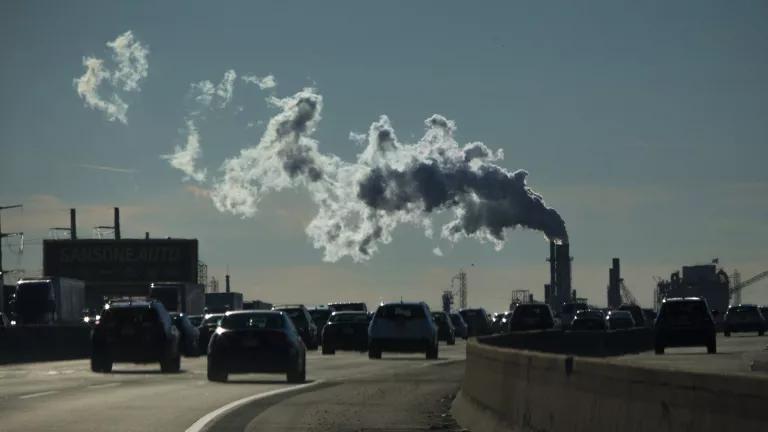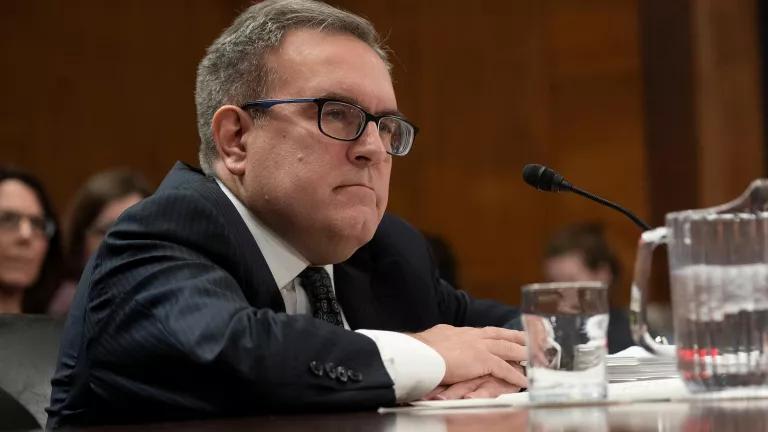Drilling Off VA Coast: An Invitation for Climate Havoc
The public is keenly aware that auctioning off public ocean waters to oil giants is not in the national interest. From catastrophic spills like the BP Deepwater Horizon disaster that oiled the entire Gulf region, to “minor” spills and almost daily leaks that coat beaches, harm marine ecosystems and human health, and disrupt local tourism and fishing industries, there is all sorts of evidence that drilling is a bad idea.

Virginia’s coast is one area in the bullseye of the Trump administration’s radical proposal to expand offshore drilling. Trump and Interior Secretary Ryan Zinke, on behalf of their oil industry allies, are proposing drilling for oil and gas all along the U.S. coastline.
This extreme proposal has been met by a bipartisan wave of opposition up and down the coast and across the country.
The public is keenly aware that auctioning off these public ocean waters to oil giants is not in the national interest. Oil drilling means oil spilling. From catastrophic spills like the BP Deepwater Horizon disaster that oiled the entire Gulf region, to “minor” spills and almost daily leaks that coat beaches, harm marine ecosystems and human health, and disrupt local tourism and fishing industries, there is all sorts of evidence that drilling is a bad idea.
These consequences are, however, only part of the picture.
More offshore drilling also means more carbon pollution and a greater risk of climate-driven harms. Burning fossil fuels is the primary driver of climate disruption, which fuels more extreme weather, sea-level rise, asthma attacks in the young, and many more harmful impacts.
Every time a new drill rig is sunk into the ocean floor, it locks in decades of more fossil fuel use. That is in part because offshore drilling is a high capital cost venture, and operations routinely take 20 to 30 years to bring oil to market, let alone to recoup costs. As a result, companies will look to squeeze every last drop of oil out of offshore wells, long after that oil would otherwise be economical and well past the point that we need to have transitioned off fossil fuels to mitigate against the worst effects of climate change.
And just like oil spills don’t stop at state borders, the climate doesn’t recognize if carbon pollution comes from rigs off the coast of Alaska, Florida, or Virginia. Whether it be in their backyard, or clear across the country, Virginians will suffer the same consequences from fossil fuels.
How Climate Change Affects Virginians
Offshore drilling is a high-stakes proposition for Virginia, a state with a $2 billion ocean economy.
Sea Level Rise and Flooding
- Virginia is ground zero for climate-driven sea level rise. For residents of coastal areas like Norfolk, there is a lot to lose and the risks are high. The Sewell’s Point tide gauge there recorded the equivalent of 18.2 inches of relative sea rise in the last 100 years, compared to the global average of 7 to 8 inches. If current trends continue, projections through 2050 suggest Hampton Roads will be tied for second place with Pensacola, Florida for the highest rates of sea level rise with increases up to 0.49 meters or 19 inches.

- Combined with extreme weather, a rise in sea levels means Virginians should expect more flooding—even on sunny days. Coastal cities have already seen an increase in minor flooding. Norfolk residents saw twice as many minor flood days in 2016 compared to 4 days in 1995, and half of Portsmouth residents reported trouble accessing their neighborhoods at least once during a sunny day flood.
- Another study finds that even without storms, 16,000 Virginians, $2 billion worth of residential properties and 300 commercial properties, currently assessed at $212 million, would be at constant risk of flooding.
- Further, flood waters disrupt roadways and evacuation routes, restricting access for emergency health services during natural disaster.
- Flooding also creates high strain on some of Virginia’s most impoverished coastal communities who already have trouble feeding their families and paying their bills.
- Combined with extreme storms, flooding also means overstrained wastewater facilities, which can lead to an overflow of sewage into coastal areas, rivers, and drinking water sources. This contaminated runoff may result in more waterborne diseases like E. coli and salmonella.
- Lastly, sea level rise also may mean saltier drinking water for coastal residents who get their water from aquifers that already sit below sea level. The lower they sit below sea level, the more risk there is for saltwater to mix with the groundwater. High concentrations of salt in drinking water can lead to higher blood pressure, which could open the door to strokes and heart attacks.
Temperature
- Climate change also brings higher temperatures. Since 1895, average maximum temperatures in Virginia have increased by 1-degree Fahrenheit, but summer highs are increasing even more quickly. In Richmond, highs averaged 88.6°F in the past decade, up one degree from 85.6°F in the 1960s.
- In extreme heat, anyone is susceptible to health risks that range from heat cramps to heat-related heart attacks. Outdoor workers, young children, older adults, people with chronic diseases, and the impoverished are especially vulnerable to these threats.
- As carbon pollution fuels more intense and frequent heat waves, Virginia’s emergency departments and urgent care clinics will see more heat-related illness and death. In the summer of 2017, 498 visits for heat-related issues were reported over just 10 days.
Worsening Air Quality, Waterborne Disease, and Pest-borne Illnesses
- Rising temperatures are already extending the season for allergenic pollen. Some studies also show that doubling carbon pollution levels could increase ragweed pollen production up to 90 percent. This means that individuals with diseases like asthma may experience more severe symptoms. This poses significant threats to health in cities like Richmond, which has the third highest pollen counts in the United States, and is rated the second-most challenging city to live in if you have asthma.

- Rising temperatures will also extend the season for harmful food-borne bacteria. For a state that is home to over 3,300 miles of marine coastline and has a thriving seafood industry, an increase in bacteria endangers not only economic prosperity but human health. For example, Virginia’s famous oysters, which contributed $35.8 million to its economy in 2016, will be more likely to carry Vibrio bacteria, which cause symptoms ranging from nausea and diarrhea to bloodstream infections and severe complications for people with weakened immune systems or chronic diseases.
- Disease-carrying pests like ticks and mosquitoes will also linger longer into the season and appear in new areas due to rising temperatures, potentially increasing the number of Virginians exposed to Lyme disease and West Nile virus.
Virginia’s Future Depends on Clean Energy
The evidence is clear. Expanding offshore drilling would put Virginia’s prized coastline and all it supports at risk of an oil spill. Drilling and burning more fossil fuels would also mean more carbon pollution. And that would contribute to a future for Virginians that is frightening and unrecognizable because of the predicted impacts of climate change—unless we change course.
It’s not enough to keep drill rigs directly off Virginia’s shores. More offshore drilling anywhere on U.S. coasts means a greater risk of the harms that climate change is already yielding. We need to prevent expanded offshore drilling across the board. Fortunately, a wave of opposition to the Trump Administration’s offshore drilling scheme means the right choices can still be made—if our elected leaders stand in solidarity and ensure that we protect all our coasts and invest federal resources in clean energy instead of more oil industry hand-outs.
The only way to we can be safe from the hazards and harms of offshore drilling anywhere is to oppose it everywhere.
Read more on the health impacts of climate change here.
Katie Hobbs provided significant contributions to this post.



